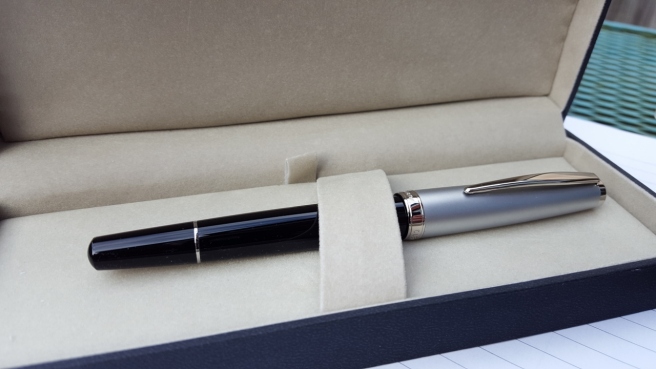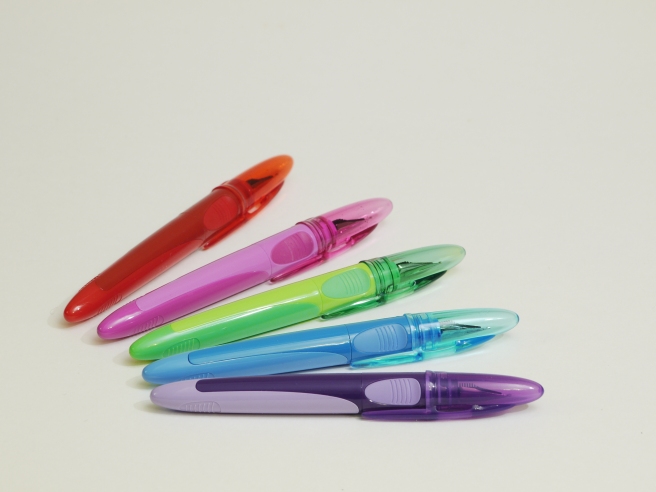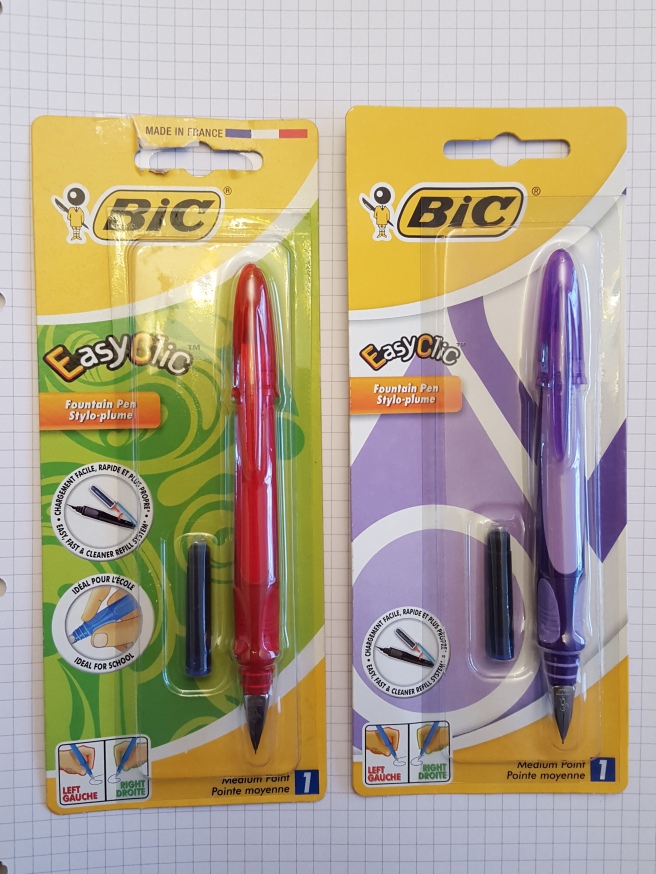
It was a joy for me to find another German brand of very nice fountain pens recently. If you have not heard of these pens before, then I recommend them to you.
My story begins a week ago when I was browsing on Cult Pens’ web site, looking at the long list of brands and noticed the name and logo of Cleo Skribent. Clicking on this out of curiosity I was taken to the page showing some of their range of pens.
The one that caught my eye particularly, (and which is the subject of this review) was a piston filler, with black barrel and brushed stainless steel cap, described by Cult Pens as a beautiful lightweight piston-filling fountain pen.
Some decision making is required as there were three options. The steel cap version comes with a stainless steel nib. But for a little extra, you may buy the 14k gold nib version. However, you no longer get the brushed stainless steel cap and instead have an all black pen with palladium fittings. This will not match the gold nib (if that is important to you) but there is a further option, for another increase in price, to have the 14k gold nib, all black pen and gold coloured fittings.
All three versions have the same large clear ink window, which appealed to me. What was not apparent from the Cult Pens pictures is that the pen has a blind cap which you unscrew to access the piston turning knob inside.

I successfully resisted ordering the pen on first viewing, to weigh up the pros and cons of the three similar models. Instead, I added a Cleo Skribent to my “wish list”. (This is not just a figure of speech but is now a spread in a bullet journal where the Cleo Skribent had to compete with, amongst other things, a Kaweco Dia 2 and a Pelikan M120N).
Meanwhile I looked for more information about Cleo Skribent. I found some favourable reviews where the stainless steel nibs were given particular praise. I found on Amazon that there was also a bordeaux option and some cartridge-converter options although I preferred the piston filler. I also found the company’s own web site and another very informative article by Jim Mamoulides on PenHero.com including the company’s history.(See link: Cleo Skribent history).
The choice of gold or steel nib, particularly given the fairly modest difference in price, was a case of head versus heart (head saying go for gold but heart saying that I prefer the brushed steel cap with steel nib) but in the end it was the brushed steel cap paired with the black barrel which won me over. Although this meant settling for the stainless steel nib, the positives were (a) I had read good reviews of the stainless steel nib, (b) its colour would match the brushed stainless steel cap (c) it was in my eyes, the most pleasing of the three to look at and (d) also the least expensive.
After the Cleo emerged victorious from its brief stay in the wish list, I looked again at the Cult Pens site. The prices of all three piston filler models had come down, since I had last looked! So on the Thursday night, I put in my order.
The parcel arrived on Saturday morning, which was ideal. First impressions were all very favourable. There is a nice black gift box with plush grey lining and colour booklet.The glossy black barrel does look very handsome paired with brushed stainless steel cap. In the cap, there is a finial with the Cleo Skribent logo in red on a black background. The pocket clip is usefully tight with a generous range of movement. The polished cap band, contrasting with the brushed finish of the cap itself, reads “CLEO made in Germany”.

The cap unscrews with two twists, to reveal the plastic threads on the section and the large clear ink window, which is fully concealed when the cap is on. The black, grip section tapers down towards the nib, ending with a chrome decorative ring.
The nib looked very nicely made. I had chosen a Fine. There is some attractive scroll work and the markings “Cleo Skribent F” beneath the logo. All looked good. The tines were even and symmetrical and the slit narrowed from the breather hole down to the tip. The black plastic feed looked streamlined with the delicate fins housed on the inside so that the exposed side of the feed was smooth. I do not yet know whether the nib and feed are friction fit and can be pulled out for cleaning or nib swapping but if so, then the absence of delicate fins on the feed reduces the risk of damage.
This is an unusually long pen. Capped, the pen stands at around 145mm which is taller than a Lamy Safari. Uncapped, the pen measures around 135mm which, for me, is very comfortable in the hand to use unposted. If you find that holding a pen helps you concentrate, then this one seems ideal for that. Somehow, holding the long slender instrument with its fine precision nib seems to aid the thought processes. It very quickly becomes comfortable and familiar in the hand. I tend to grip it with my thumb over the ink window and my first finger on the threads, which are not at all sharp.
The blind cap unscrews to reveal the knurled, black plastic turning knob of the piston. The cap can be posted, securely and deeply but does grip the blind cap and so you need to be careful not to turn the cap once posted, which would either unscrew the blind cap or over-tighten it with a risk of damage. With care, you can avoid this but I have found that the pen is very comfortable to use unposted.
The pen weighs a total of 25g inked, but remove the cap and it is then just 11.5g, which is light for a pen but with its length and build quality it does not feel insubstantial.
I tried dipping the pen first, in a new bottle of Aurora Blue. My initial reaction was that the nib was smooth but on the dry side, not because there was any downward pressure needed or any lack of lubrication but simply because the line appeared so fine and pale. I had expected the line to be a darker, more vibrant royal blue. I then flushed the pen, and filled it enjoying the first sight of the blue ink in the window.

The paleness of the line troubled me at first and I feared that this may be one of those nibs that is not perfectly tuned “out of the box” but needs some adjustment to perform correctly. However I found the pen extremely enjoyable to use and could produce very small, intricate lettering with the beautifully crafted steel nib.
I then examined the nib closely with a x7 illuminated loupe whilst writing. I realised that the nib was not dry at all. It lays down ink effortlessly and you can observe the ink glistening for several seconds before it dries. The line variation and shading are all there. The steel nib is smooth but has a little, pleasant feedback. It is firm but has just a little flex to give some variation with downward pressure. What I had wrongly thought to be due to dryness, is just a very fine line with an ink flow proportionate to the narrowness of this nib. You might class this as an extra fine if accustomed to more generous western fines.

This nib is as wet as it needs to be and if it were any wetter, it may not produce such a fine line and small lettering without ink pooling in all your loops. I concluded that there is nothing wrong with the nib at all and that the good people at Cleo Skribent know better than I. Thankfully I had not tinkered with the nib to make it any wetter, before coming to this conclusion.
I am enjoying every opportunity to use the pen. The fine point is great for making small marginal notes in printed text. It is also nice to have something a little less commonplace. Mine is currently the only one that I have seen.
It would be good to find out whether the nibs are easily interchangeable. And if not, there is always the gold nib option for next time.

















